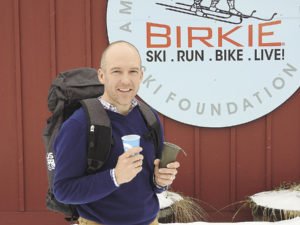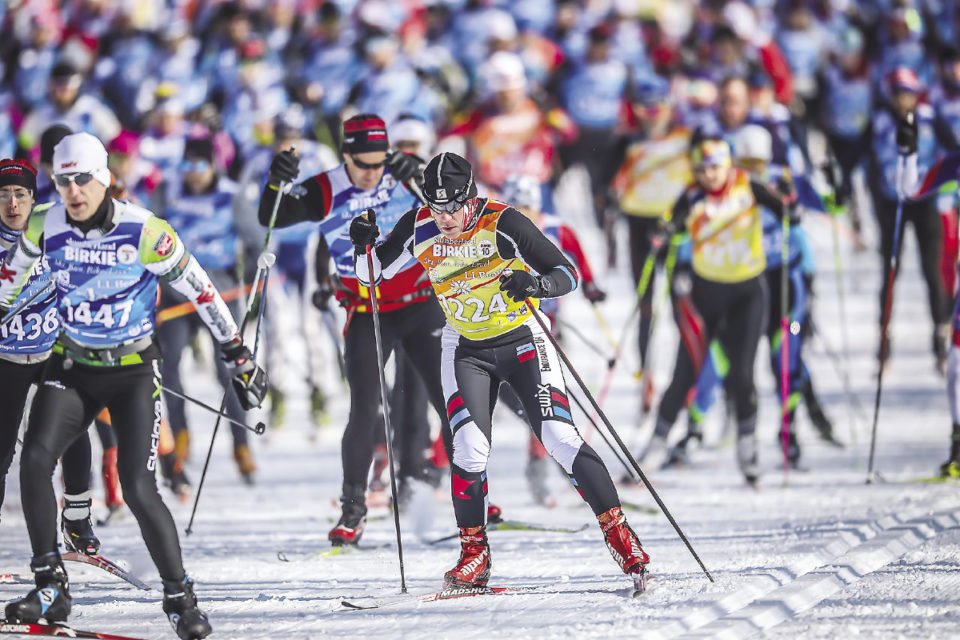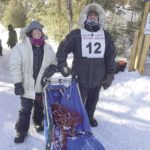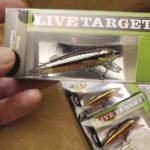Can cross-country skiing save the world?
Ben Popp, executive director of the American Birkebeiner Ski Foundation (ABSF), has enough energy and ideas to make that hyperbole feel possible.
Popp has a more manageable mission, too: ensuring the future of cross-country skiing in the Midwest. But these goals are not unrelated. Skiers united behind the sustainability of their sport may find themselves inspired toward even healthier and greener lifestyles.
Every February, Popp and his team orchestrate North America’s largest cross-country ski marathon and its accompanying events. The race course snakes through scenic, forested hills between the rural Wisconsin towns of Cable and Hayward. Skiing the 55-kilometer Birkie race is a big deal, but so is entering either of the two shorter races, or participating in the Barkie Birkie Skijor race, the kids’ races, or being one of the 2,845 volunteers or 40,000 spectators. The entire community benefits economically from the influx of visitors during race week and throughout the year.
The continued success of this world-class ski event is not a certainty. Back in 2017, after days of rain, the race was canceled for only the second time in the Birke’s 46-year history. It was disappointing, but not overly surprising. Hayward’s average winter temperature has risen 4.5 degrees Fahrenheit since 1950. The Birkie is featured right alongside maple syruping and ice fishing on the climatewisconsin.org website as Northwoods traditions that are threatened by a changing climate. Just a little farther south, ski conditions become very sporadic.
So, Popp and the ski community have their work cut out for them. What infrastructure does the trail system need to ensure consistent, quality skiing is available each winter?
Soon after the cancelled race, the Birkie purchased their first ever snowmaking equipment using donations from the ski community. A 1-kilometer loop of man-made snow first opened for skiing on November 17, 2018. This past fall, the snowmaking loop opened on November 15. Someday the man-made snow could be made efficiently during a cold spell in January, and stored over the summer. Both of these strategies give the Birkie trail crew more options for dealing with thin spots, bad weather, and whatever the future climate might throw our way.
In another move toward the future, the American Birkebeiner Ski Foundation has leased the adjacent former Telemark Resort property with an option to buy the 713-acres when the lease expires in July 2021.
Why is acquiring that land significant? “Wisconsin doesn’t have another venue that has snowmaking and hosts a big event,” explained Popp. The Telemark property—once a premier cross-country ski destination with an alpine ski area, too—has been vacant for years. Nevertheless, its 30 kilometers of ski trails are still legendary and still used for several of the Birkie’s events. Plus the property contains wells that feed the new snowmaking equipment. If the Birkie race became contingent on having most of the trail augmented with man-made snow, those trails and wells would be important.
Actually, those trails are already important to many locals and visitors, and Popp wants to restore full public access. When the Telemark property moved into private ownership after a final bankruptcy in 2013, access was restricted. “We feel like the trails and the nature experiences available there are integral to our community, and we want to be part of ensuring that the whole community can use it,” Popp told me.
While Popp and the Birkie are taking the lead on bringing Telemark back to life, they aren’t able to do it alone. It’s all about the community, says Popp. Mountain bike, ATV, and snowmobile clubs will all have a part in maintaining their respective trails on the property. The Cable Natural History Museum may help install family-friendly nature trails. That’s the easy part. The Birkie is also looking for a partner to deal with the old lodge building and either remove it or remodel it into something that would support the recreational activities. No longer will the lodge be the focal point of the property, “the draw is the amazing nature that’s there,” said Popp.

So, with snowmaking capabilities, over a hundred kilometers of trails, and a growing community of skiers, the future of the Birkie—and cross-country skiing in the Midwest—is stable, right?
Not really. Snowmaking is energy intensive. “If you make 5 kilometers of snow and use fossil fuels to do it, is that really the right thing to do, especially long term?” Popp questioned. “To make snow responsibly takes some real conscious thought and intent.” Popp is exploring ways that their snowmaking could be fueled by solar power.
The new Birkie Green initiative embodies that same conscious thought and intent toward reducing carbon emissions and environmental impacts from the ski community. It began with the Birkie Green Gear Bag, which is a durable backpack with ski-friendly features that racers use instead of plastic bags to have warm clothes transported to the finish line. If you don’t want to make the investment, you can still buy a plastic bag, but Birkie skiers have been showing off their packs getting used on adventures all over the world, under the hashtag #BirkieBagAdventure.
Last summer, the Birkie Trail Run switched to reusable silicone cups that racers carry with them to aid stations. The Birkie Tour ski event used stainless steel cups with carabiner handles for the first time in January. Post-race food is now eaten from compostable containers, and beer is served in cans to facilitate recycling. By putting in plenty of forethought, and getting their partners involved, the Trail Run ended up with just a single bag of garbage.
Popp wants to see the Birkie use its leverage to get vendors and contractors committed to going green, too. For example, the sports nutrition company called GU has a recycling program that accepts the empty single-serving packets from energy gels of any brand. Swix is moving to ski waxes that are healthier for skiers and for the environment. These and more will be highlighted at the Birkie Expo, so that skiers can make educated decisions about the companies they support.
One of the biggest components of Birkie Green is the new Samuel C. Johnson Family Outdoor Center at the OO Trailhead near the halfway point of the Birkie trail system. The beautiful facility boasts passive solar design, an EV car charger, solar lighting, and a water bottle filling station. Its value isn’t limited to showcasing these increasingly common features, though.
The facility—which sees 100,000 users in a year—makes it easier for skiers of all levels to enjoy the trails and the experience, and to feel like they are part of a community. In addition, book clubs, mountain bike workshops, high school teams, the Nordic Kids club, and more, use this welcoming space. By making active lifestyles fun, easy, and social, the Birkie has a positive impact on the health and well-being of the surrounding communities—and that’s despite the race spreading a highly contagious fever.
For thousands of folks, Birkie Fever—“a craving for excitement, camaraderie and challenge”—is a real thing. But it’s not just about skiing fast or helping out with a single week of activities; it’s about the energy that comes from being part of something bigger than yourself. And that’s where Popp’s power lies. What if the Foundation’s new Birkie Green initiatives could get the ski community to think about sustainability in every aspect of their lives? What if skiers become advocates and ambassadors for green practices? What if Popp really could use skiing to help save the world?






